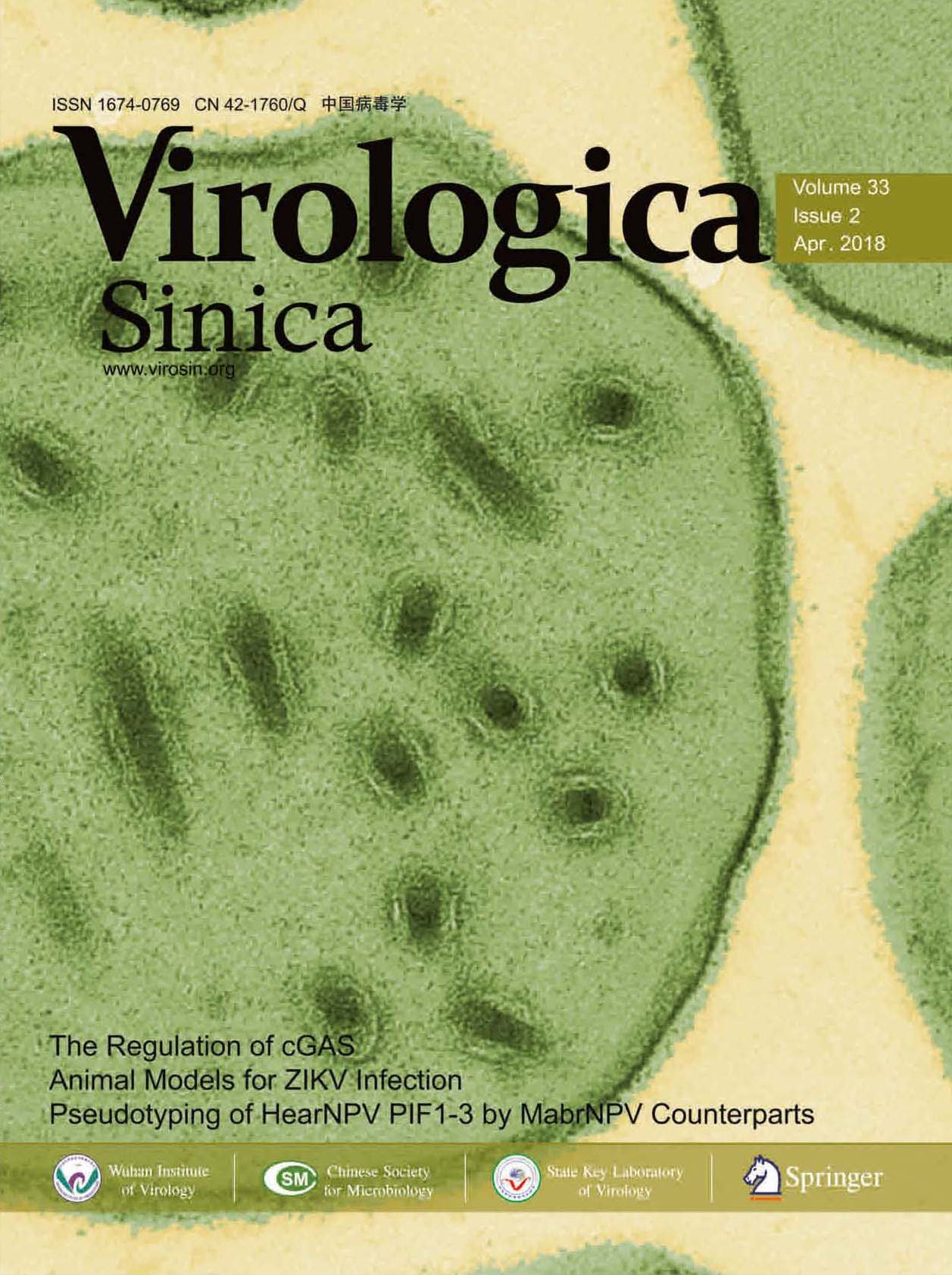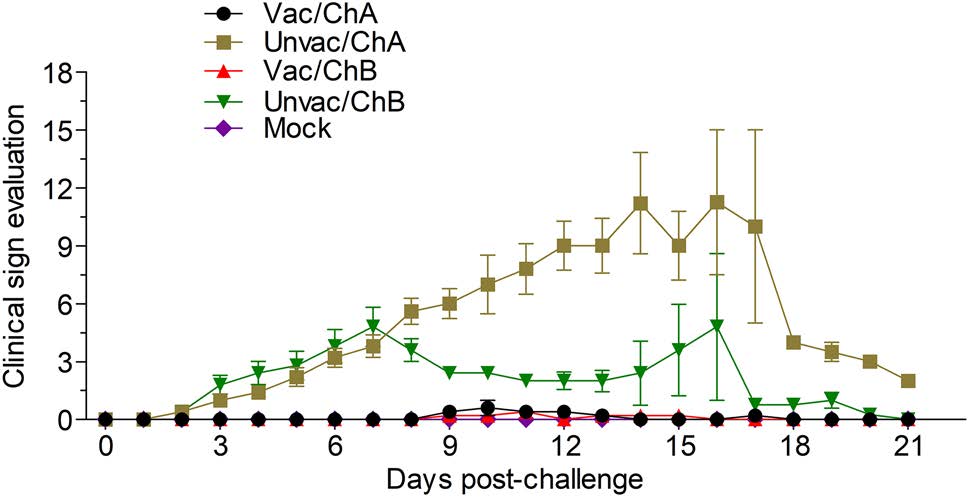-
Allende R, Lewis T, Lu Z, Rock D, Kutish G, Ali A, Doster A, Osorio F (1999) North American and European porcine reproductive and respiratory syndrome viruses differ in non-structural protein coding regions. J Gen Virol 80:307-315
doi: 10.1099/0022-1317-80-2-307
-
Bai X, Wang Y, Xu X, Sun Z, Xiao Y, Ji G, Li Y, Tan F, Li X, Tian K (2016) Commercial vaccines provide limited protection to NADC30-like PRRSV infection. Vaccine 34:5540-5545
doi: 10.1016/j.vaccine.2016.09.048
-
Brockmeier SL, Loving CL, Vorwald AC, Kehrli ME, Baker RB, Nicholson TL, Lager KM, Miller LC, Faaberg KS (2012) Genomic sequence and virulence comparison of four Type 2 porcine reproductive and respiratory syndrome virus strains. Virus Res 169:212-221
doi: 10.1016/j.virusres.2012.07.030
-
Calzada-Nova G, Husmann RJ, Schnitzlein WM, Zuckermann FA (2012) Effect of the host cell line on the vaccine efficacy of an attenuated porcine reproductive and respiratory syndrome virus. Vet Immunol Immunopathol 148:116-125
doi: 10.1016/j.vetimm.2012.05.008
-
Faaberg KS, Kehrli ME, Lager KM, Guo B, Han J (2010) In vivo growth of porcine reproductive and respiratory syndrome virus engineered nsp2 deletion mutants. Virus Res 154:77-85
doi: 10.1016/j.virusres.2010.07.024
-
Galliher-Beckley A, Li X, Bates JT, Madera R, Waters A, Nietfeld J, Henningson J, He D, Feng W, Chen R (2015) Pigs immunized with Chinese highly pathogenic PRRS virus modified live vaccine are protected from challenge with North American PRRSV strain NADC-20. Vaccine 33:3518-3525
doi: 10.1016/j.vaccine.2015.05.058
-
Halbur P, Miller L, Paul P, Meng X-J, Huffman E, Andrews J (1995a) Immunohistochemical identification of porcine reproductive and respiratory syndrome virus (PRRSV) antigen in the heart and lymphoid system of 3-week-old colostrum-deprived pigs. Vet Pathol 32:200-204
doi: 10.1177/030098589503200218
-
Halbur P, Paul P, Frey M, Landgraf J, Eernisse K, Meng X-J, Lum M, Andrews J, Rathje J (1995b) Comparison of the pathogenicity of two US porcine reproductive and respiratory syndrome virus isolates with that of the Lelystad virus. Vet Pathol 32:648-660
doi: 10.1177/030098589503200606
-
Halbur PG, Paul PS, Meng XJ, Lum MA, Andrews JJ, Rathje JA (1996) Comparative pathogenicity of nine US porcine reproductive and respiratory syndrome virus (PRRSV) isolates in a 5-week-old cesarean-derived, colostrum-deprived pig model. J Vet Diagn Invest 8:11-20
doi: 10.1177/104063879600800103
-
Holtkamp DJ, Kliebenstein JB, Neumann EJ, Zimmerman JJ, Rotto HF, Yoder TK, Wang C, Yeske PE, Mowrer CL, Haley CA (2013) Assessment of the economic impact of porcine reproductive and respiratory syndrome virus on United States pork producers. J Swine Health Prod 21:72-84
-
Huang C, Zhang Q, W-h Feng (2015) Regulation and evasion of antiviral immune responses by porcine reproductive and respiratory syndrome virus. Virus Res 202:101-111
doi: 10.1016/j.virusres.2014.12.014
-
Kim DY, Kaiser TJ, Horlen K, Keith ML, Taylor LP, Jolie R, Calvert JG, Rowland RR (2009) Insertion and deletion in a non-essential region of the nonstructural protein 2 (nsp2) of porcine reproductive and respiratory syndrome (PRRS) virus: effects on virulence and immunogenicity. Virus Genes 38:118-128
doi: 10.1007/s11262-008-0303-4
-
Lager KM, Schlink SN, Brockmeier SL, Miller LC, Henningson JN, Kappes MA, Kehrli ME, Loving CL, Guo B, Swenson SL (2014) Efficacy of Type 2 PRRSV vaccine against Chinese and Vietnamese HP-PRRSV challenge in pigs. Vaccine 32:6457-6462
doi: 10.1016/j.vaccine.2014.09.046
-
Leng X, Li Z, Xia M, He Y, Wu H (2012a) Evaluation of the efficacy of an attenuated live vaccine against highly pathogenic porcine reproductive and respiratory syndrome virus in young pigs. Clin Vaccine Immunol 19:1199-1206
doi: 10.1128/CVI.05646-11
-
Leng X, Li Z, Xia M, Li X, Wang F, Wang W, Zhang X, Wu H (2012b) Mutations in the genome of the highly pathogenic porcine reproductive and respiratory syndrome virus potentially related to attenuation. Vet Microbiol 157:50-60
doi: 10.1016/j.vetmic.2011.12.012
-
Li X, Galliher-Beckley A, Huang H, Sun X, Shi J (2013) Peptide nanofiber hydrogel adjuvanted live virus vaccine enhances crossprotective immunity to porcine reproductive and respiratory syndrome virus. Vaccine 31:4508-4515
doi: 10.1016/j.vaccine.2013.07.080
-
Li C, Zhuang J, Wang J, Han L, Sun Z, Xiao Y, Ji G, Li Y, Tan F, Li X (2016a) Outbreak Investigation of NADC30-like PRRSV in South-East China. Transbound Emerg Dis 63:474-479
doi: 10.1111/tbed.2016.63.issue-5
-
Li Z, He Y, Xu X, Leng X, Li S, Wen Y, Wang F, Xia M, Cheng S, Wu H (2016b) Pathological and immunological characteristics of piglets infected experimentally with a HP-PRRSV TJ strain. BMC Vet Res 12:230
doi: 10.1186/s12917-016-0854-x
-
Liu C, Ning Y, Xu B, Gong W, Zhang D (2016) Analysis of genetic variation of porcine reproductive and respiratory syndrome virus (PRRSV) isolates in Central China. J Vet Med Sci 78:641-648 Mateu E, Diaz I (2008) The challenge of PRRS immunology. Vet J 177:345-351
doi: 10.1292/jvms.15-0570
-
Mengeling WL, Lager KM, Vorwald AC, Clouser DF (2003) Comparative safety and efficacy of attenuated single-strain and multi-strain vaccines for porcine reproductive and respiratory syndrome. Vet Microbiol 93:25-38
doi: 10.1016/S0378-1135(02)00426-1
-
Nelson EA, Christopher-Hennings J, Benfield DA (1994) Serum immune responses to the proteins of porcine reproductive and respiratory syndrome (PRRS) virus. J Vet Diagn Invest 6:410-415
doi: 10.1177/104063879400600402
-
Opriessnig T, Baker RB, Halbur PG (2007) Use of an experimental model to test the efficacy of planned exposure to live porcine reproductive and respiratory syndrome virus. Clin Vaccine Immunol 14:1572-1577
doi: 10.1128/CVI.00332-07
-
Park C, Seo HW, Kang I, Jeong J, Choi K, Chae C (2014) A new modified live porcine reproductive and respiratory syndrome vaccine improves growth performance in pigs under field conditions. Clin Vaccine Immunol 21:1350-1356
doi: 10.1128/CVI.00377-14
-
Renukaradhya GJ, Meng X-J, Calvert JG, Roof M, Lager KM (2015) Live porcine reproductive and respiratory syndrome virus vaccines: current status and future direction. Vaccine 33:4069-4080
doi: 10.1016/j.vaccine.2015.06.092
-
Roof M, Vaughn E, Burkhart K, Faaberg K (2003) Efficacy of modified live virus porcine reproductive and respiratory virus vaccines against heterologous respiratory challenge. In: Proceedings—4th international symposium on emerging and reemerging pig diseases, Rome, pp 117-118
-
Sun Z, Wang J, Bai X, Ji G, Yan H, Li Y, Wang Y, Tan F, Xiao Y, Li X (2016) Pathogenicity comparison between highly pathogenic and NADC30-like porcine reproductive and respiratory syndrome virus. Arch Virol 161:2257-2261
doi: 10.1007/s00705-016-2883-y
-
Tian K, Yu X, Zhao T, Feng Y, Cao Z, Wang C, Hu Y, Chen X, Hu D, Tian X (2007) Emergence of fatal PRRSV variants: unparalleled outbreaks of atypical PRRS in China and molecular dissection of the unique hallmark. PLoS ONE 2:e526
doi: 10.1371/journal.pone.0000526
-
Tian ZJ, An TQ, Zhou YJ, Peng JM, Hu SP, Wei TC, Jiang YF, Xiao Y, Tong GZ (2009) An attenuated live vaccine based on highly pathogenic porcine reproductive and respiratory syndrome virus (HP-PRRSV) protects piglets against HP-PRRS. Vet Microbiol 138:34-40
doi: 10.1016/j.vetmic.2009.03.003
-
Wei Z, Zhang J, Zhuang J, Sun Z, Gao F, Yuan S (2013) Immunization of pigs with a type 2 modified live PRRSV vaccine prevents the development of a deadly long lasting hyperpyrexia in a challenge study with highly pathogenic PRRSV JX143. Vaccine 31:2062-2066
doi: 10.1016/j.vaccine.2013.02.012
-
Zhang C, Guo L, Jia X, Wang T, Wang J, Sun Z, Wang L, Li X, Tan F, Tian K (2015) Construction of a triple gene-deleted Chinese Pseudorabies virus variant and its efficacy study as a vaccine candidate on suckling piglets. Vaccine 33:2432-2437
doi: 10.1016/j.vaccine.2015.03.094
-
Zhang Q, Jiang P, Song Z, Lv L, Li L, Bai J (2016) Pathogenicity and antigenicity of a novel NADC30-like strain of porcine reproductive and respiratory syndrome virus emerged in China. Vet Microbiol 197:93-101
doi: 10.1016/j.vetmic.2016.11.010
-
Zhao K, Ye C, Chang XB, Jiang CG, Wang SJ, Cai XH, Tong GZ, Tian ZJ, Shi M, An TQ (2015) Importation and recombination are responsible for the latest emergence of highly pathogenic porcine reproductive and respiratory syndrome virus in China. J Virol 89:10712-10716
doi: 10.1128/JVI.01446-15
-
Zhou YJ, Hao XF, Tian ZJ, Tong GZ, Yoo D, An TQ, Zhou T, Li GX, Qiu HJ, Wei TC (2008) Highly virulent porcine reproductive and respiratory syndrome virus emerged in China. Transbound Emerg Dis 55:152-164
doi: 10.1111/j.1865-1682.2008.01020.x
-
Zhou L, Wang Z, Ding Y, Ge X, Guo X, Yang H (2015) NADC30-like strain of porcine reproductive and respiratory syndrome virus, China. Emerg Infect Dis 21:2256
doi: 10.3201/eid2112.150360
-
Zhou J, Li S, Wang X, Zou M, Gao S (2017) Bartha-k61 vaccine protects growing pigs against challenge with an emerging variant pseudorabies virus. Vaccine 35:1161-1166
doi: 10.1016/j.vaccine.2017.01.003















